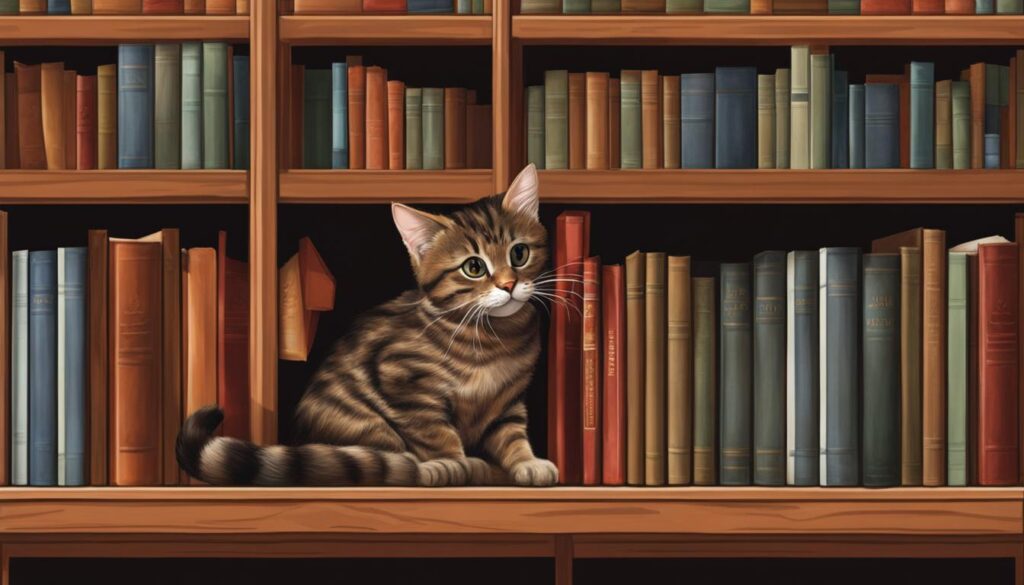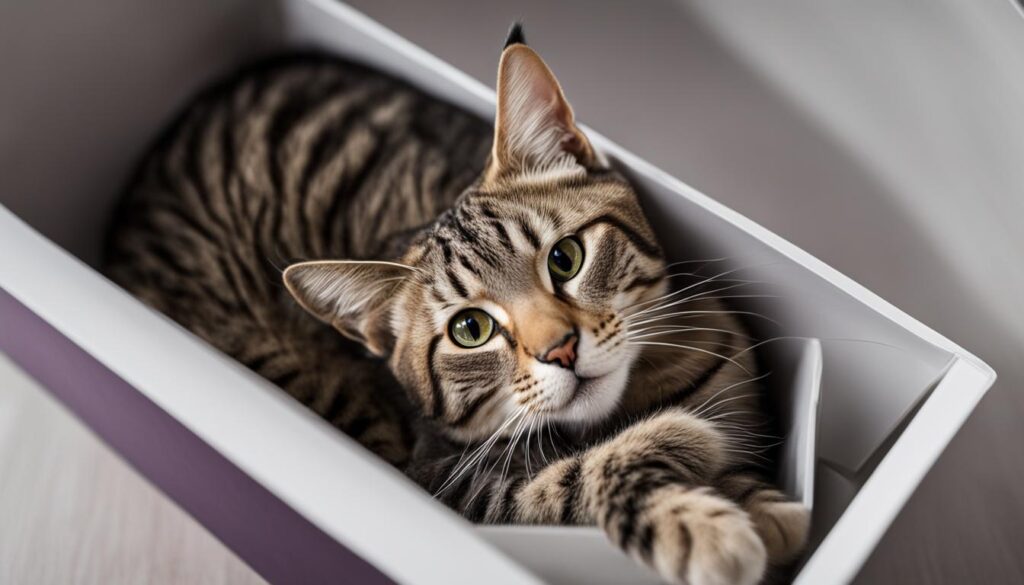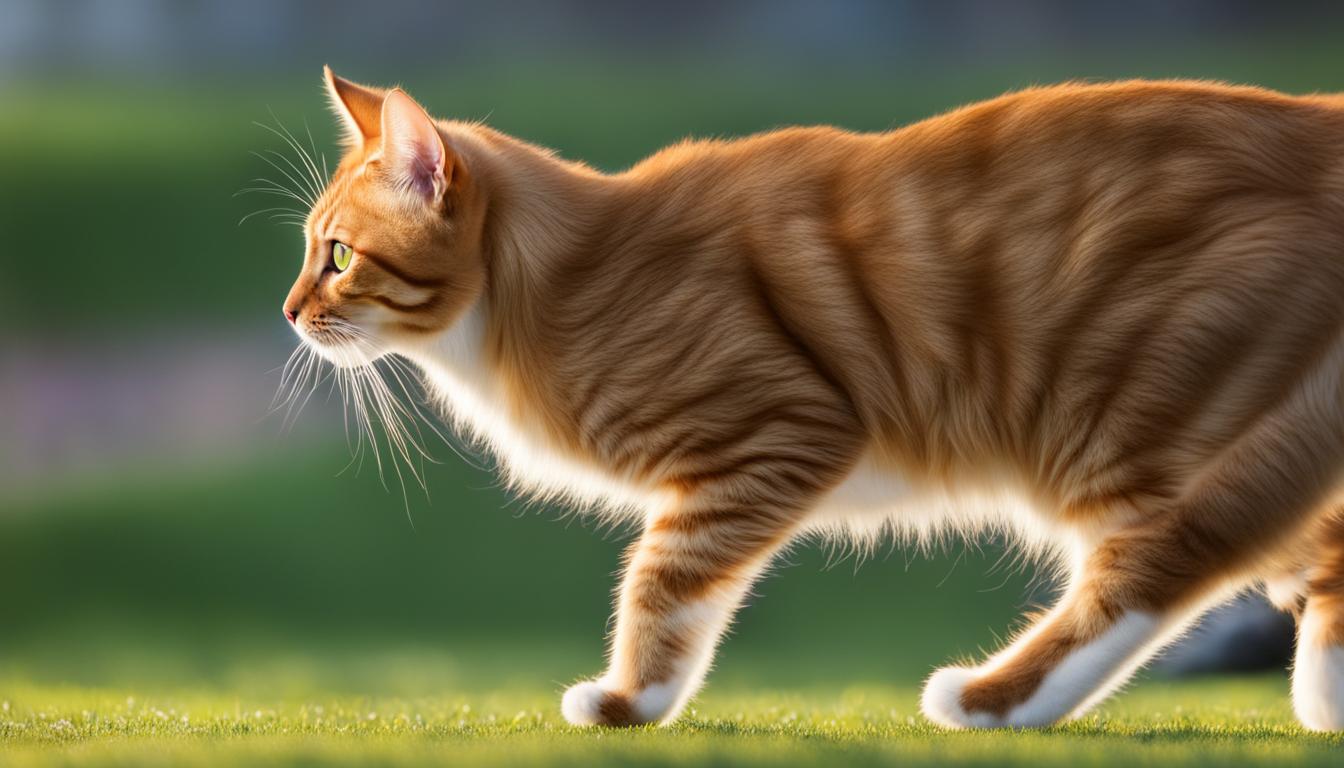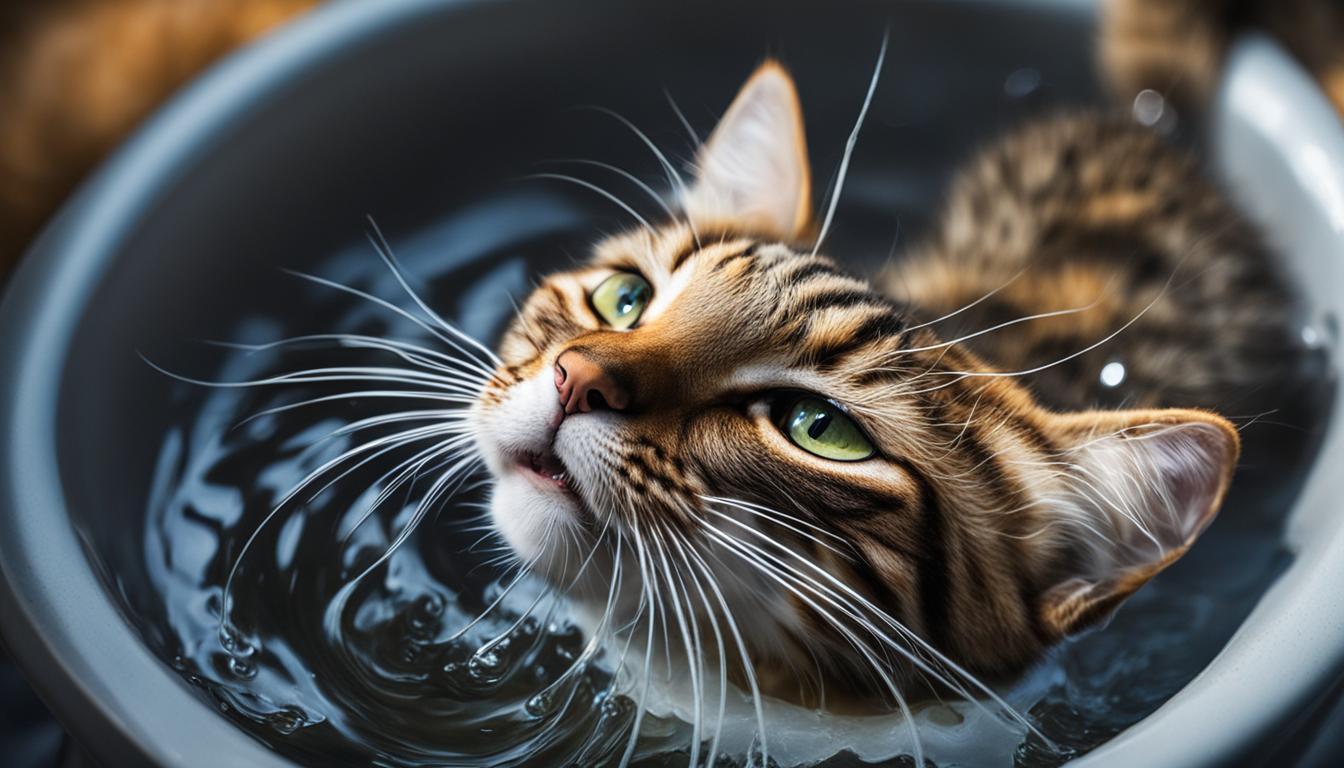Have you ever marveled at the way cats effortlessly slide into the tiniest of spaces? It’s as if they possess a secret superpower that allows them to defy the laws of physics. But fear not, fellow feline enthusiasts, for I am here to shed light on the science behind this incredible phenomenon.
Cats are masters of compression, capable of contorting their bodies in ways that seem impossible. From squeezing into shoeboxes to cozying up in narrow crevices, they have an uncanny ability to fit into the most compact of spaces. But what exactly enables them to achieve such a feat?
- The flexibility of a cat’s spine allows them to twist and turn with remarkable ease.
- Whiskers act as guides, providing cats with vital information about their surroundings.
- The unique anatomy of cats, including their lack of a rigid collarbone, contributes to their ability to narrow their shoulders and chest.
- While cats can navigate through tight spaces, there are physical limits to the size of openings they can maneuver.
- Cats’ compression ability is an evolutionary adaptation that aids in their hunting prowess.
So the next time you witness your furry friend contorting themselves to fit into a minuscule box or hiding spot, remember that it is not just magic at play. It is a combination of flexibility, anatomy, and sensory awareness that allows cats to conquer even the tightest of spaces.
The Flexibility of a Cat’s Spine
One of the most remarkable aspects of a cat’s ability to squeeze into tight spaces is the extraordinary flexibility of their spines. Unlike humans and many other animals, cats have spines that are highly flexible and can twist and turn to a much greater extent. The vertebrae in a cat’s back are connected in a flexible manner and have elastic cushioning disks, providing them with the ability to perform their acrobatic feats.
This spinal flexibility not only allows cats to navigate through narrow openings, but it also contributes to their speed and agility. With such a flexible spine, cats can contort their bodies in ways that humans can only dream of, allowing them to fit into even the smallest corners. This ability is a testament to the incredible adaptability of cats and their unique anatomical features.
Cats’ spinal flexibility is an essential part of their natural behavior. It allows them to move swiftly and gracefully, enabling them to stalk prey effectively. It also aids in their ability to pounce and jump with precision, making them formidable hunters. Their flexible spines are a key factor in their overall agility and grace, showcasing the incredible athleticism of these fascinating creatures.
| Comparison of Spinal Flexibility | Cats | Humans |
|---|---|---|
| Range of Motion | Highly flexible and can twist and turn to a great extent | Relatively limited range of motion compared to cats |
| Ability to Fit through Tight Spaces | Capable of squeezing into narrow openings due to spinal flexibility | Limited by the rigidity of the human spine |
| Speed and Agility | Enhanced by the flexibility of their spines | Not directly influenced by spinal flexibility |
(Table: Comparison of Spinal Flexibility in Cats and Humans)
The Role of Whiskers in Squeezing
Whiskers are not just cute adornments on a cat’s face; they play a crucial role in a cat’s ability to squeeze into tight spaces. These specialized sensory hairs, known as vibrissae, are as wide as a cat’s body and serve as important tools for spatial awareness. When a cat approaches a narrow opening, its whiskers brush against the sides, sending signals to sensory nerves that help the cat gauge whether the space is wide enough to fit through.
Cats rely on their whiskers to navigate their surroundings with remarkable precision. The sensory information provided by the whiskers allows them to detect subtle changes in their environment and determine whether a particular opening or passage is suitable for exploration. By using their whiskers as guides, cats can confidently maneuver through narrow gaps without the risk of getting stuck.
“Whiskers are like cat antennas, providing valuable feedback about the world around them. They not only help cats assess the width of tight spaces but also act as an early warning system, alerting them to potential obstacles or hazards,” says Dr. Emily Sullivan, a feline behavior expert.
The whiskers’ incredible sensitivity allows cats to navigate tight spaces even in low-light conditions, where their vision may be compromised. They serve as an additional layer of protection, preventing cats from attempting to squeeze through openings that are too narrow and potentially injure themselves. So, next time you see your cat gracefully slipping through a small gap, remember the essential role their whiskers play in making this seemingly impossible feat possible.
| Role of Whiskers in Squeezing | Benefits |
|---|---|
| Cat’s spatial awareness | Helps cats assess the width of tight spaces |
| Early warning system | Alerts cats to potential obstacles or hazards |
| Enhances navigation | Allows cats to maneuver through narrow gaps even in low-light conditions |
The Anatomy of a Compact Cat
Cats possess a unique anatomy that allows them to excel in navigating tight spaces. One notable feature is their ability to narrow their shoulders and chest, enabling them to squeeze through even the smallest openings. Unlike humans, cats lack a rigid collarbone, which would restrict their movement and limit their access to confined areas. Instead, they have tiny rudimentary collarbones that further contribute to their flexibility and maneuverability.
A closer look at a cat’s skeletal structure reveals the absence of a fixed collarbone and the presence of highly flexible vertebrae in their back. This design allows cats to twist and turn their bodies with ease, adapting to the shape of the space they are trying to enter. These flexible vertebrae, coupled with elastic cushioning disks, grant cats the ability to contort their bodies and make their way through narrow gaps.
The cat’s ability to narrow its shoulders, combined with its flexible spine, creates a feline powerhouse when it comes to reaching cramped spaces. Their unique anatomy gives them an advantage in their natural hunting environment, allowing them to navigate tricky terrain and seek out prey with agility and precision.

Table: A Comparison of Cat Anatomy with Other Animals
| Cat | Human | Dog | |
|---|---|---|---|
| Shoulder and Chest Flexibility | Highly flexible, narrow | Less flexible, wider | Moderately flexible, medium width |
| Presence of Collarbone | Tiny rudimentary collarbone | Rigid collarbone | Rigid collarbone |
| Spinal Flexibility | Highly flexible | Less flexible | Moderately flexible |
This table highlights the distinct anatomical differences between cats, humans, and dogs. Cats have the narrowest shoulders and chest, making them well-suited for squeezing into tight spaces. Their tiny collarbone and highly flexible spine further enhance their ability to maneuver through confined areas. In comparison, humans and dogs have wider shoulders, rigid collarbones, and less spinal flexibility, making them less adept at navigating cramped quarters.
Understanding the anatomy of a cat provides valuable insights into their remarkable ability to fit into compact spaces. As we marvel at their agility and knack for finding cozy nooks, we can appreciate the unique design that makes this possible. Cats truly embody the saying, “If I fits, I sits,” thanks to their fascinating anatomy.
The Physical Limits of Cats in Tight Spaces
When it comes to squeezing into tight spaces, cats seem almost invincible. They can effortlessly maneuver through narrow gaps and find themselves comfortably nestled in the smallest of openings. However, even these agile felines have their physical limits. Research suggests that spaces narrower than 5 centimeters may prove too tight for cats to squeeze through, regardless of their slim physiques.
While cats possess remarkable flexibility and adaptability, there are practical constraints to their ability to navigate small openings. These limits are due to the size and structure of a cat’s body, including its shoulders and chest. Unlike humans, cats have the advantage of a flexible spine and lack a rigid collarbone, allowing them to narrow their bodies and contort themselves into spaces that may appear impossible to squeeze into.
Despite their incredible physical abilities, cats still face restrictions when it comes to tight spaces. Understanding these limitations can help cat owners create an environment that ensures their pets’ safety while still providing opportunities for exploration and play.

The Importance of Providing Suitable Spaces
As cat owners, it is crucial to provide our feline friends with suitable spaces that cater to their natural instincts and need for comfort. While cats may have an impressive ability to squeeze into tight spaces, it’s important to strike a balance between providing cozy nooks and ensuring their safety. Offering a variety of appropriately sized hiding spots and climbing structures can satisfy their desire for enclosed spaces while minimizing the risk of injury or getting stuck.
Tailoring the Environment for Our Furry Companions
Creating a cat-friendly environment involves understanding their physical limits and preferences. By observing their behavior and interactions with different spaces, we can identify their preferred nooks and crannies. Additionally, providing access to vertical spaces, such as high shelves or cat trees, can give cats a sense of security and allow them to survey their surroundings from a safe vantage point. Remember to consider their unique personalities and adjust the environment accordingly to ensure their well-being and happiness.
| Physical Limitations of Cats in Tight Spaces | Key Takeaways |
|---|---|
| Cats find it challenging to squeeze through spaces narrower than 5 centimeters. | Understanding the limits of a cat’s ability to navigate tight spaces can help create a safe environment. |
| Their physical limitations are due to the size and structure of their bodies, including their shoulders and chest. | Providing suitable spaces that cater to a cat’s need for comfort and security is crucial. |
| Observing a cat’s behavior can help identify their preferred hiding spots and climbing structures. | Tailoring the environment to meet a cat’s preferences can promote their well-being and happiness. |
The Science of Feline Compression
When it comes to fitting into tight spaces, cats have honed their compression skills over millions of years of evolution. This unique ability sets them apart from many other animals and is a testament to their adaptability as hunters and predators. While other animals may struggle to squeeze through narrow openings, cats have a distinct advantage thanks to their flexible spines, freedom of shoulder movement, and the use of their whiskers for spatial awareness.
Compared to other animals, cats possess a remarkable level of spinal flexibility. Their vertebrae are connected in a highly flexible manner, allowing for an impressive range of motion. This flexibility enables cats to twist and turn their bodies, contorting themselves to fit into spaces that may seem impossible for their size. In contrast, other animals with less flexible spines would find it much more challenging to navigate tight spaces.
The compression abilities of cats also extend to their shoulders and chest. Unlike humans and many other animals, cats do not have a rigid collarbone. This lack of a rigid structure allows them to narrow their shoulders and chest, further enhancing their ability to slide through small openings. Additionally, cats have rudimentary collarbones that provide additional flexibility, giving them an advantage when maneuvering in confined spaces.
Perhaps one of the most fascinating aspects of a cat’s compression ability is the role of their whiskers. These specialized hairs are not just for show; they play a crucial role in helping cats navigate tight spaces. By brushing against surfaces, the whiskers provide cats with sensory feedback, allowing them to determine whether a space is wide enough to pass through without getting stuck. The whiskers act as an early warning system, ensuring that cats can safely maneuver through narrow openings.

Conclusion
After exploring the fascinating science behind a cat’s ability to squeeze into tight spaces, it’s clear that there’s more to it than meets the eye. The flexible spines, unique anatomy, and sensory capabilities of cats all play a role in their uncanny talent for fitting into the smallest corners.
But why do cats love tight spaces? While it’s still a subject of speculation, one theory suggests that small, enclosed spaces provide cats with a sense of security and comfort. These spaces mimic the cozy hiding spots that cats seek in the wild, offering them a safe retreat where they can observe their surroundings without feeling exposed.
The science of feline compression goes beyond just their physical abilities. It is an adaptation that has evolved over time, enabling cats to be successful hunters. Their compact size and exceptional compression ability give them the advantage they need to pursue and capture prey effectively.
Understanding the science behind a cat’s squeeze into tight spaces can help us appreciate their agility and adapt our homes to provide them with safe and comfortable spaces to explore. So, the next time you catch your feline friend slipping into a small box or nook, remember that it’s not magic but the result of their incredible anatomical features and evolutionary traits.
FAQ
How do cats squeeze into tight spaces?
Cats have highly flexible spines that allow them to twist and turn to a much greater extent than humans. This flexibility, along with elastic cushioning disks in their vertebrae, enables them to navigate tight spaces with ease.
How do cats use their whiskers to navigate tight spaces?
Cats rely on their whiskers to gauge whether they can fit into tight spaces. Whiskers are as wide as a cat’s body and provide essential information about their surroundings. By brushing against surfaces, the whiskers send signals to sensory nerves, allowing cats to detect changes in their environment and determine if they can squeeze through narrow openings without getting stuck.
Does a cat’s anatomy contribute to their ability to squeeze into tight spaces?
Yes, a cat’s anatomy plays a significant role in their ability to fit into tight spaces. Unlike humans, cats do not have a rigid collarbone, which would hinder their movement. Cats can narrow their shoulders and chest, allowing them to squeeze through almost impossibly tight openings. Their tiny rudimentary collarbones also contribute to their flexibility and maneuverability in confined spaces.
Are there limits to a cat’s ability to fit into tight spaces?
Yes, research suggests that spaces narrower than 5 centimeters may be too tight for cats to squeeze through, even for slimmer felines. While cats have impressive flexibility, there are physical limits to the size of openings they can maneuver.
Why can cats squeeze into tight spaces?
Cats’ ability to squeeze into compact spaces is an evolutionary adaptation that has allowed them to be successful predators. Their flexible spines, freedom of shoulder movement, and the use of whiskers for spatial awareness give them a competitive advantage in their natural hunting environment.





